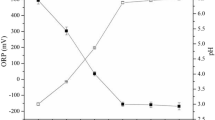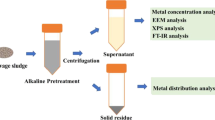Abstract
The heavy metals content and dewaterability of municipal sewage sludge (MSS) are important parameters affecting its subsequent disposal and land application. Six kinds of inoculums were prepared to examine the characteristics of heavy metals removal and MSS dewaterability improvement in bioleaching processes. The results showed that Cu, Zn and Cd bioleaching efficiencies (12 days) were 81–91, 87–93 and 81–89 %, respectively, which were significantly higher than those of Fe–S control (P < 0.05) and blank control (P < 0.01). The bioleaching boosted by the prepared inoculums could also significantly enhance MSS dewaterability (P < 0.01). The centrifugal dehydration efficiency of MSS rose from 73.00 to 90.00 % at day 12. Microscopic observations and energy dispersive spectrum analysis demonstrated that the dewaterability improvement might be attributed to the changes of sludge structure from flocculent to obvious granular and the formation of secondary minerals mainly consisting of iron, oxygen and sulfur elements. The results above demonstrated that bacterial consortium enriched from acid mine drainage (AMD) was suitable to boost sludge bioleaching for heavy metals removal and dewaterability improvement. It also suggested that the synergy of sulfur/ferrous-oxidizing bacteria (SFOB) enriched from AMD and the cooperation of exogenous and indigenous SFOB significantly promoted bioleaching efficiencies.






Similar content being viewed by others
References
Baba AA, Adekola FA, Atata RF, Ahmed RN, Panda S (2011) Bioleaching of Zn (II) and Pb(II) from Nigerian sphalerite and galena ores by mixed culture of acidophilic bacteria. Trans Nonferrous Met Soc China 21:2535–2541
Baker BJ, Banfield JF (2003) Microbial communities in acid mine drainage. FEMS Microbiol Ecol 44:139–152
Bouchez T, Jacob P, d’Hugues P, Durand A (2006) Acidophilic microbial communities catalyzing sludge bioleaching monitored by fluorescent in situ hybridization. Antonie Van Leeuwenhoek 89:435–442
Carranza F, Romero R, Mazuelos A, Iglesias N, Forcat O (2009) Biorecovery of copper from converter slags: slags characterization and exploratory ferric leaching tests. Hydrometallurgy 97:39–45
Chen SY, Lin JG (2001) Bioleaching of heavy metals from sediment: significance of pH. Chemosphere 41:1093–1102
Chen SY, Lin JG (2004) Bioleaching of heavy metals from livestock sludge by indigenous sulfur-oxidizing bacteria: effects of sludge solids concentration. Chemosphere 54:283–289
Chen YX, Hua YM, Zhang SH, Tian GM (2005) Transformation of heavy metal forms during sewage sludge bioleaching. J Hazard Mater 123:196–202
Crundwell FK (2003) How do bacteria interact with minerals. Hydrometallurgy 71:75–81
Daoud J, Karamanev D (2006) Formation of jarosite during Fe2+ oxidation by Acidithiobacillus ferrooxidans. Miner Eng 19:960–967
Deneux-Mustin S, Lartiges BS, Villemin G, Thomas F, Yvon J, Bersillon JL, Snidaro D (2001) Ferric chloride and lime conditioning of activated sludge: an electron microscopic study on resin-embedded samples. Water Res 35:3018–3024
Elektorowicz M, Muslat Z (2008) Removal of heavy metals from oil sludge using ion exchange textiles. Environ Technol 29:393–399
Fu FL, Wang Q (2011) Removal of heavy metal ions from wastewaters: a review. J Environ Manage 92:407–418
Hseu ZY (2004) Evaluating heavy metal contents in nine composts using four digestion methods. Bioresour Technol 95:53–59
Kim IS, Lee JU, Jang A (2005) Bioleaching of heavy metals from dewatered sludge by Acidithiobacillus ferrooxidans. J Chem Technol Biotechnol 80:1339–1348
Krishnamurthy S, Viraraghavan T (2005) Chemical conditioning for dewatering municipal wastewater sludges. Energy Sources 27:113–122
Kumar RN, Nagendran R (2007) Influence of initial pH on bioleaching of heavy metals from contaminated soil employing indigenous Acidithiobacillus thiooxidans. Chemosphere 66:1775–1781
Kumar RN, Nagendran R (2008) Changes in nutrient profile of soil subjected to bioleaching for removal of heavy metals using Acidithiobacillus thiooxidans. J Hazard Mater 156:102–107
Li C, Zhou LX, Wang SM (2008) Bioleaching of heavy metals from municipal sludge by the co-inoculation of two acidophilic Thiobacillus. Acta Sci Circumst 28:1155–1160
Liao YH, Zhou LX, Bai SY, Liang JR, Wang SM (2009a) Occurrence of biogenic schwertmannite in sludge bioleaching environments and its adverse effect on solubilization of sludge-borne metals. Appl Geochem 24:1739–1746
Liao YH, Zhou LX, Liang JR, Xiong HX (2009b) Biosynthesis of schwertmannite by Acidithiobacillus ferrooxidans cell suspensions under different pH condition. Mater Sci Eng 29:11–15
Liu YG, Zhou M, Zeng GM, Li X, Xu WH, Fan T (2007) Effect of solids concentration on removal heavy metals from mine tailings via bioleaching. J Hazard Mater 141:202–208
Liu FW, Zhou J, Wang DZ, Zhou LX (2012a) Enhancing sewage sludge dewaterability by bioleaching approach with comparison to other physical and chemical conditioning methods. J Environ Sci 24:1403–1410
Liu FW, Zhou LX, Zhou J, Song XW, Wang DZ (2012b) Improvement of sludge dewaterability and removal of sludge-borne metals by bioleaching at optimum pH. J Hazard Mater 211:170–177
Loser C, Zehnsdorf A, Gorsch K, Seidel H (2006) Bioleaching of heavy metal polluted sediment influence of temperature and oxygen (part 1). Eng Life Sci 6:355–363
Marchioretto MM, Bruning H, Loan NTP, Rulkens WH (2002) Heavy metals extraction from anaerobically digested sludge. Water Sci Technol 46:1–8
Mosekiemang T, Dikinya O (2012) Efficiency of chelating agents in retaining sludge-borne heavy metals in intensively applied agricultural soils. Int J Environ Sci Technol 9:129–134
Na S, Kim YU, Khim J (2007) Physiochemical properties of digested sewage sludge with ultrasonic treatment. Ultrason Sonochem 14:281–285
Naoum C, Fatta D, Haralambous KJ, Loizidou M (2001) Removal of heavy metals from sewage sludge by acid treatment. J Environ Sci Health A 36:873–881
Neyens E, Baeyens J (2003) A review of thermal sludge pre-treatment processes to improve dewaterability. J Hazard Mater 98:51–67
Pathak A, Dastidar MG, Sreekrishnan TR (2009) Bioleaching of heavy metals from sewage sludge: a review. J Environ Manage 90:2343–2353
Shen SB, Tyagi RD, Blais JF, Surampalli RY (2003) Bacterial leaching of metals from tannery sludge by indigenous sulfur-oxidizing bacteria: the effect of sludge solids concentration. J Environ Eng ASCE 129:513–519
Sreekrishnan TR, Tyagi RD, Blais JF, Campbell PGC (1993) Kinetics of heavy metal bioleaching from sewage sludge—II. Mathematical model. Water Res 27:1641–1661
Wang X, Chen T, Ge YH, Jia YF (2008) Studies on land application of sewage sludge and its limiting factors. J Hazard Mater 160:554–558
Wang JW, Bai JF, Xu JQ, Liang B (2009) Bioleaching of metals from printed wire boards by Acidithiobacillus ferrooxidans and Acidithiobacillus thiooxidans and their mixture. J Hazard Mater 172:1100–1105
Wen YM, Wang QP, Tang CX, Chen ZL (2012) Bioleaching of heavy metals from sewage sludge by Acidithiobacillus thiooxidans: a comparative study. J Soil Sediment 12:900–908
Xiang L, Chan LC, Wong JWC (2000) Removal of heavy metals from anaerobically digested sewage sludge by isolated indigenous iron-oxidizing bacteria. Chemosphere 41:283–287
Xiang Y, Wu PX, Zhu NW, Zhang T, Liu W, Wu JH, Li P (2010) Bioleaching of copper from waste printed circuit boards by bacterial consortium enriched from acid mine drainage. J Hazard Mater 84:812–818
Xiong HX, Liao YH, Zhou LX (2008) Influence of chloride and sulfate on formation of akaganeite and schwertmannite through ferrous biooxidation by Acidithiobacillus ferrooxidans cells. Environ Sci Technol 42:8681–8686
Yu Q, Lei HY, Yu GW, Feng X, Li ZX, Wu ZC (2009) Influence of microwave irradiation on sludge dewaterability. Chem Eng J 155:88–93
Zhang PY, Zhu Y, Zhang GM, Zou S, Zeng GM, Wu Z (2009) Sewage sludge bioleaching by indigenous sulfur-oxidizing bacteria: effects of ratio of substrate dosage to solid content. Bioresour Technol 100:1394–1398
Zhou SG, Zhou LX (2006) Adsorption and coprecipitation of dissolved metals with jarosite under conditions simulating sewage sludge bioleaching. Spectrosc Spectr Anal 26:966–970
Acknowledgments
This work was financially supported by National Natural Science Foundation of China (No. 51178191) and Program for New Century Excellent Talents in University (No. NCET-11-0166).
Author information
Authors and Affiliations
Corresponding author
Ethics declarations
Conflict of interest
None.
Rights and permissions
About this article
Cite this article
Shi, C., Zhu, N., Shang, R. et al. Simultaneous heavy metals removal and municipal sewage sludge dewaterability improvement in bioleaching processes by various inoculums. World J Microbiol Biotechnol 31, 1719–1728 (2015). https://doi.org/10.1007/s11274-015-1922-2
Received:
Accepted:
Published:
Issue Date:
DOI: https://doi.org/10.1007/s11274-015-1922-2




